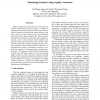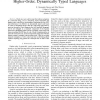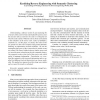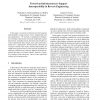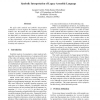WCRE
2005
IEEE
14 years 8 months ago
2005
IEEE
The use of design patterns in a software system can provide strong indications about the rationale behind the system’s design. As a result, automating the detection of design pa...
WCRE
2005
IEEE
14 years 8 months ago
2005
IEEE
Buffer overflows have been the most common form of security vulnerability in the past decade. A number of techniques have been proposed to address such attacks. Some are limited t...
WCRE
2005
IEEE
14 years 8 months ago
2005
IEEE
In recent years, code obfuscation has attracted attention as a low cost approach to improving software security by making it difficult for attackers to understand the inner worki...
WCRE
2005
IEEE
14 years 8 months ago
2005
IEEE
Software decay is a phenomenon that plagues aging software systems. While in recent years, there has been significant progress in the area of automatic detection of “code smells...
WCRE
2005
IEEE
14 years 8 months ago
2005
IEEE
— Chuck is a new code browser that allows navigation of a code base along semantic structures, such as data-flow and higher-order control-flow relationships. Employing the fast...
WCRE
2005
IEEE
14 years 8 months ago
2005
IEEE
Understanding a software system by just analyzing the structure of the system reveals only half of the picture, since the structure tells us only how the code is working but not w...
WCRE
2005
IEEE
14 years 8 months ago
2005
IEEE
In this paper we present an infrastructure that supports interoperability among various reverse engineering tools and applications. We include an Application Programmer’s Interf...
WCRE
2005
IEEE
14 years 8 months ago
2005
IEEE
It is a common understanding that identifying the same entity such as module, file, and function between revisions is important for software evolution related analysis. Most softw...
WCRE
2005
IEEE
14 years 8 months ago
2005
IEEE
The architecture of many large software systems is rarely documented and if documented it is usually out of date. To support developers maintaining and evolving these systems, an ...
WCRE
2005
IEEE
14 years 8 months ago
2005
IEEE
We apply static analysis and symbolic interpretation techniques to reverse engineer the semantics of legacy assembler code. We examine the case of IBM-1800 programs in detail. Fro...

